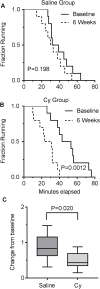Cyclophosphamide leads to persistent deficits in physical performance and in vivo mitochondria function in a mouse model of chemotherapy late effects
- PMID: 28700655
- PMCID: PMC5507312
- DOI: 10.1371/journal.pone.0181086
Cyclophosphamide leads to persistent deficits in physical performance and in vivo mitochondria function in a mouse model of chemotherapy late effects
Abstract
Fatigue is the symptom most commonly reported by long-term cancer survivors and is increasingly recognized as related to skeletal muscle dysfunction. Traditional chemotherapeutic agents can cause acute toxicities including cardiac and skeletal myopathies. To investigate the mechanism by which chemotherapy may lead to persistent skeletal muscle dysfunction, mature adult mice were injected with a single cyclophosphamide dose and evaluated for 6 weeks. We found that exposed mice developed a persistent decrease in treadmill running time compared to baseline (25.7±10.6 vs. 49.0±16.8 min, P = 0.0012). Further, 6 weeks after drug exposure, in vivo parameters of mitochondrial function remained below baseline including maximum ATP production (482.1 ± 48.6 vs. 696.2 ± 76.6, P = 0.029) and phosphocreatine to ATP ratio (3.243 ± 0.1 vs. 3.878 ± 0.1, P = 0.004). Immunoblotting of homogenized muscles from treated animals demonstrated a transient increase in HNE adducts 1 week after exposure that resolved by 6 weeks. However, there was no evidence of an oxidative stress response as measured by quantitation of SOD1, SOD2, and catalase protein levels. Examination of mtDNA demonstrated that the mutation frequency remained comparable between control and treated groups. Interestingly, there was evidence of a transient increase in NF-ĸB p65 protein 1 day after drug exposure as compared to saline controls (0.091±0.017 vs. 0.053±0.022, P = 0.033). These data suggest that continued impairment in muscle and mitochondria function in cyclophosphamide-treated animals is not linked to persistent oxidative stress and that alternative mechanisms need to be considered.
Conflict of interest statement
Figures






References
-
- Ahlberg K, Ekman T, Gaston-Johansson F, Mock V. Assessment and management of cancer-related fatigue in adults. Lancet. 2003;362:640–50. doi: 10.1016/S0140-6736(03)14186-4 - DOI - PubMed
-
- al-Majid S, McCarthy DO. Cancer-induced fatigue and skeletal muscle wasting: the role of exercise. Biol Res Nurs. 2001;2(3):186–97. doi: 10.1177/109980040100200304 - DOI - PubMed
-
- Banthia R, Malcarne VL, Roesch SC, Ko CM, Greenbergs HL, Varni JW, et al. Correspondence between daily and weekly fatigue reports in breast cancer survivors. J Behav Med. 2006;29(3):269–79. doi: 10.1007/s10865-006-9053-8 - DOI - PubMed
-
- Berger AM, Abernethy AP, Atkinson A, Barsevick AM, Breitbart WS, Cella D, et al. Cancer-related fatigue. J Natl Compr Canc Netw. 2010;8(8):904–31. - PubMed
-
- Calvani R, Joseph AM, Adhihetty PJ, Miccheli A, Bossola M, Leeuwenburgh C, et al. Mitochondrial pathways in sarcopenia of aging and disuse muscle atrophy. Biol Chem. 2013;394(3):393–414. doi: 10.1515/hsz-2012-0247 - DOI - PMC - PubMed
MeSH terms
Substances
Grants and funding
LinkOut - more resources
Full Text Sources
Other Literature Sources
Research Materials
Miscellaneous

